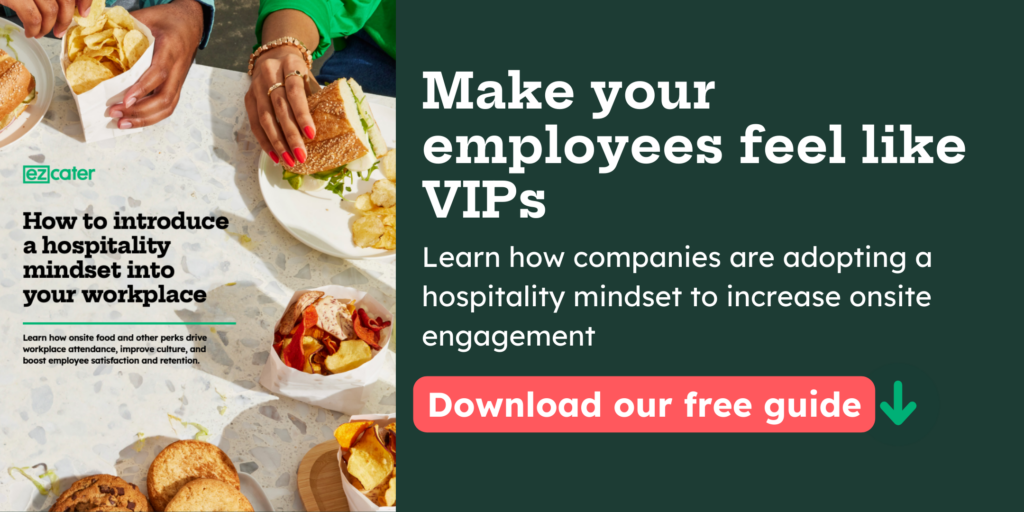How a Hospitality Mindset Can Improve Employee Experience
- Rita Cunha
- •
- 3 Min Read
- •
Human resource and employee experience teams have worked hard over the last few years to bring video software, communication tools, and desk-booking programs to the office in order to accommodate their hybrid workforce. Despite those efforts, many workers are still resisting the commute.
The thing is, those tools and resources are the bare minimum that employers need to provide in order to encourage onsite attendance and attract the best talent. To really stand out in this competitive landscape, companies have to level up their efforts to improve the onsite employee experience, and not just enforce in-office mandates.

That’s where a hospitality mindset comes in. People leaders can create a workplace where people actually want to work — by taking a few pages from the hospitality industry’s playbook. In our guide, “How to Introduce a Hospitality Mindset Into Your Workplace,” we discuss how food and other employee perks can drive workplace attendance, improve culture, and boost employee satisfaction and retention. But for now, let’s dig deeper.
How a hospitality mindset applies to the office setting
More and more employers are realizing that workers who report onsite because they want to, not because they have to, are the most productive and collaborative.
Research backs this up. The American Psychological Association found that 93% of workers who feel valued by their employers are motivated to do their best every day. They also tend to stay at their jobs for longer: only 1 in 5 say they would consider quitting and taking a position somewhere else.

The hospitality mindset is a win-win for everyone: workers feel happy, and employers see a boost in attendance, employee engagement, and talent retention.
Incorporating the right workplace perks is key
Companies that provide benefits that appeal broadly to employees — and save them time, money, and reduce their mental load — are most successful in bringing life back into the office. Choosing perks that create an environment that’s even better than home will go even further in encouraging onsite attendance, and genuine excitement about coming in and collaborating with coworkers.

This isn’t a new idea, it just hasn’t always been applied in the most productive ways. Traditionally, companies have defaulted to organizing after-work happy hours as a perk. But this can feel like a burden for employees who just want to (or need to!) get home quickly after a long, tiring day.
Successfully bringing the hospitality mindset to your workplace means picking perks that make sense for your team’s lifestyle, needs, and interests.
Examples of real company perks
Modern businesses are already applying the hospitality mindset with attractive benefits packages.
Employees at Trupanion, an insurance provider for cats and dogs, enjoy pet-friendly perks — from a corporate dog-walking service to a doggie play area.

Employees at Genentech, a biotechnology corporation, can get onsite haircuts, spa treatments, and car washes.
For workers at NorthPoint Development, a commercial real estate operating company, lunch is fully covered. Using Relish, employees select the meals they want each day from a rotating list of favorite local restaurants.
These are just some of the many ways you can treat your employees like they’re VIPs.
Five ways to treat employees like VIPs
Offering the right onsite perks can transform an ordinary workplace into a warm, inviting, and fun home-away-from-home environment. Here are five high-value workplace perks that will make your employees feel appreciated, recognized, and valued.
1. Time-saving perks

Offering dog walking, dry cleaning, car washing, laundry services, and personal package delivery at the workplace makes sense for workers. They can bundle all these life admin tasks and chores together and get them done in one go while at the office. It frees up their after-work and weekend schedules for fun things.
2. Food and beverage perks

For 44% of American workers, free food is one of the top work perks. It makes sense, they can enjoy a delicious meal without having to plan ahead or pack a lunch — which 63% of employees say they don’t do. In the end, a free lunch saves workers over $200 per month.
It doesn’t have to be lunch. You could do free breakfast, hire an onsite barista, offer grab-and-go snacks, or do a company-wide midday snack break. Food as a perk can even encourage cross-department networking and collaboration.

3. Health and wellness perks

Having an onsite therapist, a meditation room, and yoga classes can boost employees’ mental well-being. So do gym memberships, group walks, and one-on-one time with a nutritionist. Companies wanting to invest in their workers’ health are bringing these employee perks to the office.
4. Personal care perks

Who doesn’t like a bit of extra pampering? Consider offering manicures and pedicures, haircuts, onsite medical or dental clinics, and subscriptions to mindfulness and meditation apps. They all go a long way in showing your employees you value them, and that coming to the office is worth it.
5. Financial perks

Gen Z and Millennial workers tend to feel less financially stable than their older peers. Company-sponsored personal finance lectures, trainings, and onsite financial coaches and tax services can help ease their stress and worries — all while communicating to workers “we value you.”
The hospitality mindset is the future of business
Developing a workplace culture inspired by the hospitality industry pays off. It boosts office attendance through attractive perks that make it worthwhile for employees to leave the comforts of working from home. Happy workers are engaged, more creative and productive, and less likely to leave. In today’s rapidly changing and increasingly competitive work environment, employee perks make all the difference.
Free food is the perfect place to start. 86% of employers say they’ve seen a boost in attendance once they started offering food. And HR professionals agree: they are 20% more likely to say that subsidized food has the best ROI compared to other perks.
Learn more about how food and other onsite perks can give your organization the upper hand by downloading our guide. You’ll find actionable steps for bringing life back into the office.








